Intel’s response to Apple M1 series and AMD Ryzen processors has arrived — at least, partially.
Intel at CES 2022 took the wraps off its new 12th-gen “Alder Lake” mobile processors, and the chipmaker is focusing for now on H-series processors meant for high-performance and gaming laptops.
Only briefly mentioned were the upcoming 28W Alder Lake-P series CPUs for high-performance ultra-thin laptops and 15W/9W U-series chips for low-power, ultra-mobile devices. Several laptops debuting at CES use these processors, but we’ll have to wait on Intel for more details.
How Intel 12th-Gen Hybrid Technology Works
The new 45-watt H-series CPUs are based on the hybrid layout we saw on the high-end 12th-gen desktop versions launched last October. Similar to Apple’s M1 line, Intel’s chips are comprised of performance P-cores (Golden Cove) and efficiency E-cores (Gracemont) that work together to achieve faster speeds and longer battery life. In this setup, the larger P-cores handle intensive foreground workloads while the smaller E-cores power background tasks.
Intel uses F1 racing cars as an analogy to explain why this composition works better than simply stuffing a processor with full-power cores. The hybrid vehicles it references use turbocharged combustion engines to achieve top speeds but add electric power to shoot through corners. In the same way, these P and E cores work in tandem to achieve the best results.
This isn’t a new technique; in fact, smartphones have used big and little cores for years. And before launching Alder Lake, Intel’s now-retired Lakefield processors used a similar hybrid setup albeit on a much smaller scale (one performance and four efficiency cores). What will likely be remembered as a pilot program for bringing hybrid tech to x86-64 was adopted by only two devices, Samsung’s Galaxy Book S and Lenovo’s ThinkPad X1 Fold, and struggled to run basic tasks.
Intel 12th-Gen Alder Lake SKUs and Specs
That won’t be the case with these new 12th-gen chips, which are based on Intel’s enhanced 10nm SuperFin node (known as Intel 7). Available in eight different SKUs to start, ranging from a Core i5-12450H to a Core i9-12900HK, Intel’s H-series processors go up to 14 cores in a 6P:8E configuration with a maximum turbo frequency of 5.0 GHz.
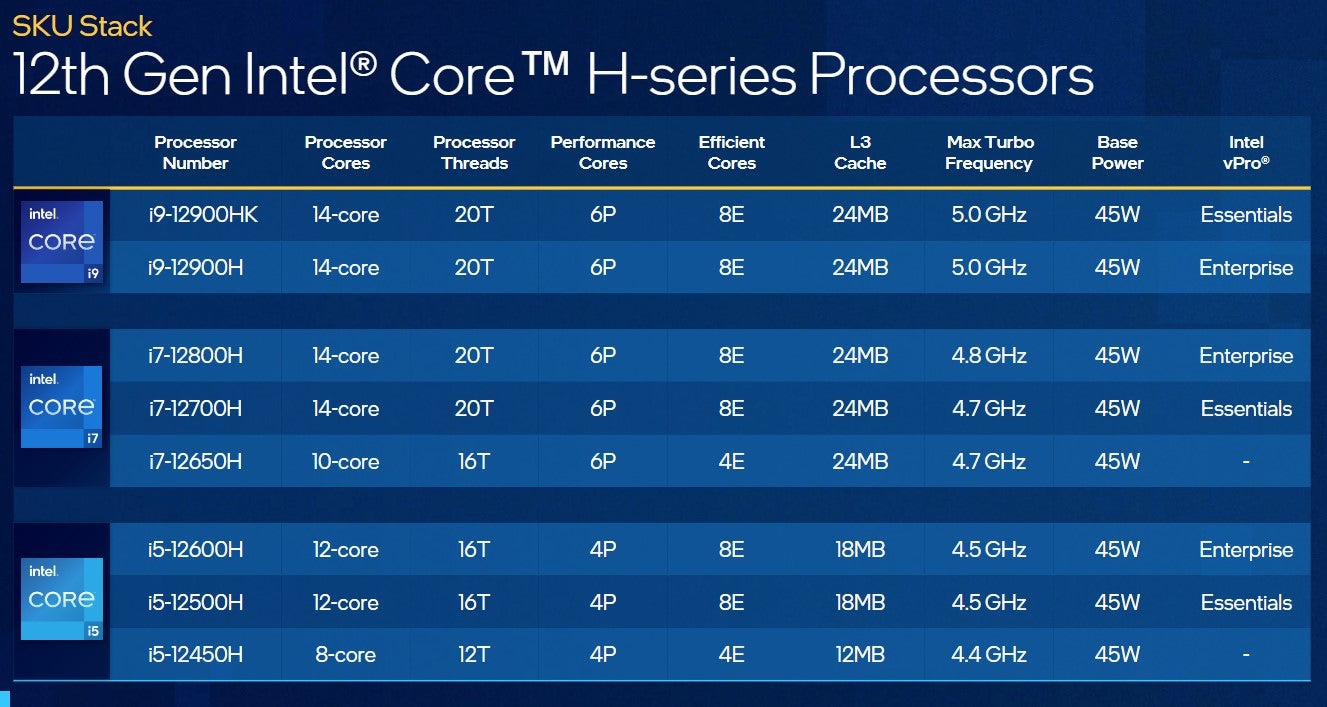
Here’s a breakdown of the 28W H-series models:
-
Core i9-12900HK: 14 cores (6P:8E), 20 threads, 24MB L3 Cache, 5.0Ghz Max Turbo
-
Core i9-12900H: 14 cores (6P:8E), 20 threads, 24MB L3 Cache, 5.0 GHz Max Turbo
-
Core i7-12800H: 14 cores (6P:8E), 20 threads, 24MB L3 Cache, 4.8Ghz Max Turbo
-
Core i7-12700H: 14 cores (6P:8E), 20 threads, 24MB L3 Cache, 4.7Ghz Max Turbo Core i7-12650H: 10 cores (6P:4E), 16 threads, 24MB L3 Cache, 4.7Ghz Max Turbo
-
Core i5-12600H: 12 cores (4P:8E), 16 threads, 18MB L3 Cache, 4.5Ghz Max Turbo
-
Core i5-12500H: 12 cores (4P:8E), 16 threads, 18MB L3 Cache, 4.5Ghz Max Turbo
-
Core i5-12450H: 8 cores (4P:4E), 12 threads, 12MB L3 Cache, 4.4Ghz Max Turbo
Before talking about performance, let me stress that the below figures are based on Intel’s internal testing. You should view them with scepticism until we can confirm the results, and just know that every chipmaker likes to cherry-pick results that make their products look best. We don’t blame them, but it means we’re only be getting half the story. And with that, Intel makes the bold claim that its 12th-gen H-series chips are the “fastest mobile processor ever,” outpacing Apple’s M1 Max on power-to-performance. Let’s take a closer look.
Intel 12th-Gen Vs. Apple M1 Vs. AMD Ryzen
Intel compared the top-of-the-stack Core i9-12900HK processor to those from AMD and Apple by pitting an MSI GE76 Raider with a Core i9 CPU and RTX 3080 GPU against a MacBook Pro 16 with an M1 Max and a Lenovo Legion with a Ryzen 9 5900HK CPU and an RTX 3080.
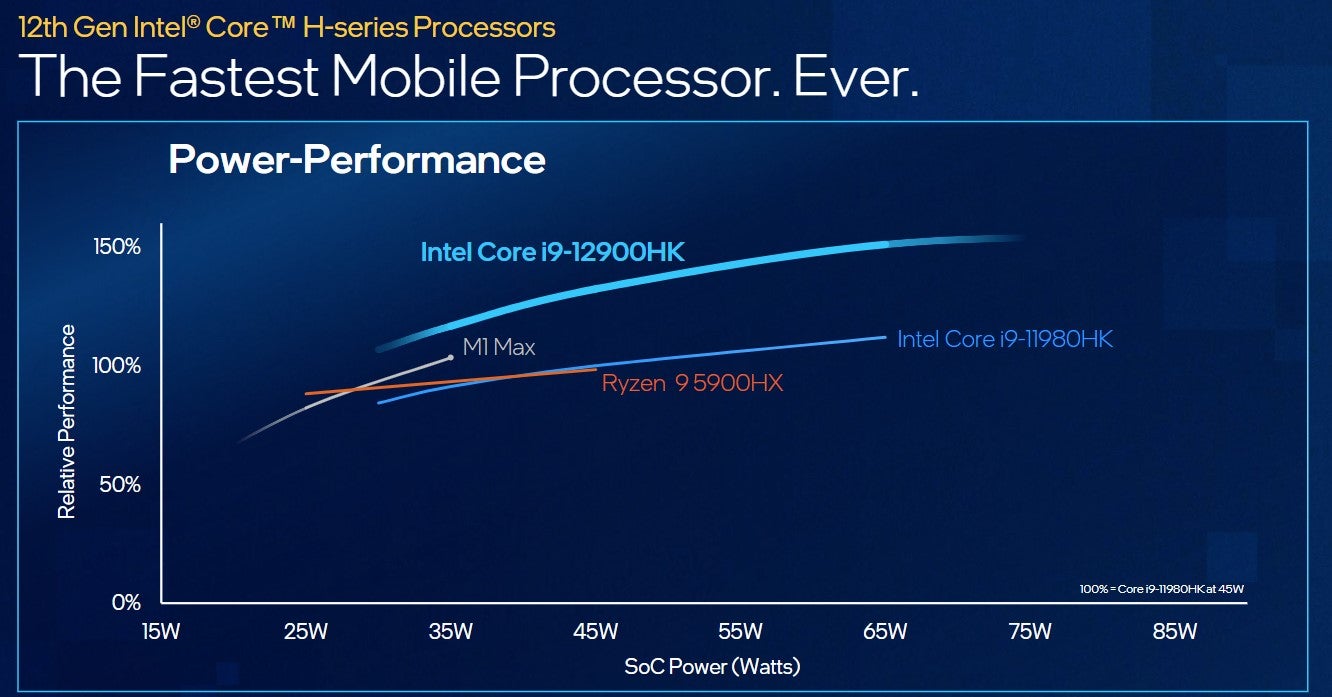
It claims the Core i9 topped each of its rivals in the PugetBench Premiere Pro and PugetBench Lightroom Classic benchmarks while achieving 44% and 10% gains, respectively, over last gen’s Core i9-11980HK. It also topped its rivals in the Autodesk Autocad benchmark, climbing 14% over its predecessor.
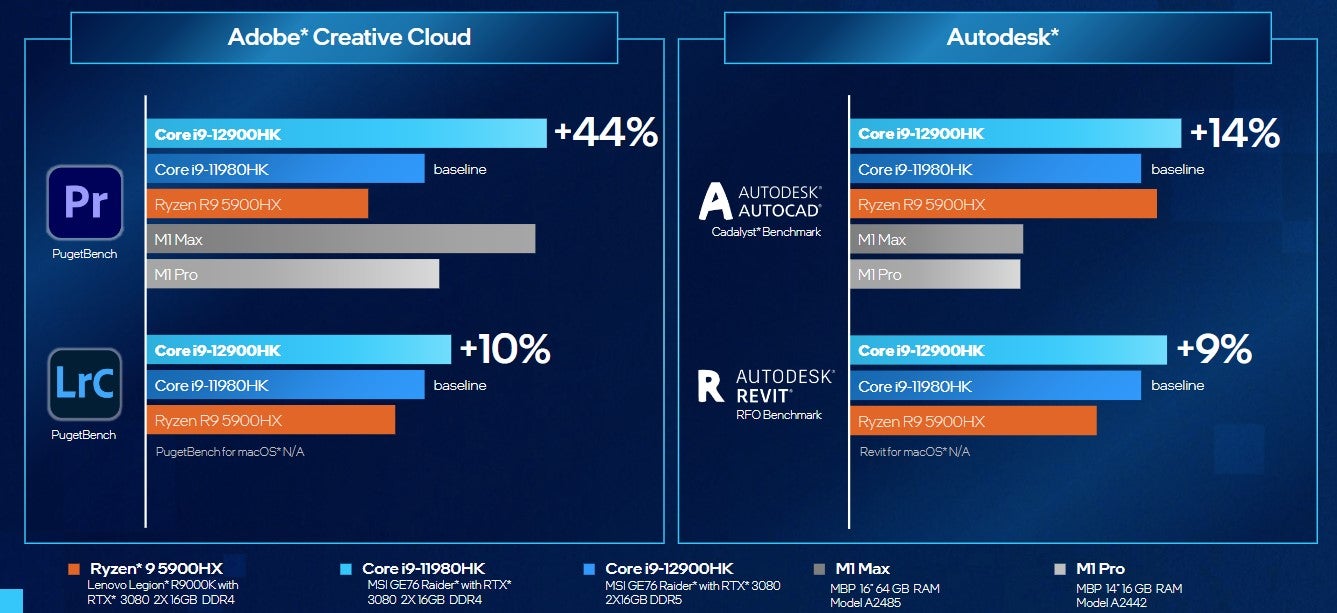
Since Intel is focusing on high-power H-series chips, we need to talk about gaming laptops, one of two categories set to be powered by these processors (the other being laptops made for content creators). Team Blue has always excelled in this area, and these 12th-gen products appear to widen the gap, if only marginally. Games like Assassin’s Creed: Valhalla, Gears 5, and GTA V didn’t see much of a performance boost, while Hitman 3, League of Legends, and F1 2021 enjoyed significant gains going from 11th to 12th-gen processors. Games best optimised to take advantage of Alder Lake could see up to a 28% speed increase, Intel claims, using Hitman 3 as an example of a title that got up to 8% higher frames per second.
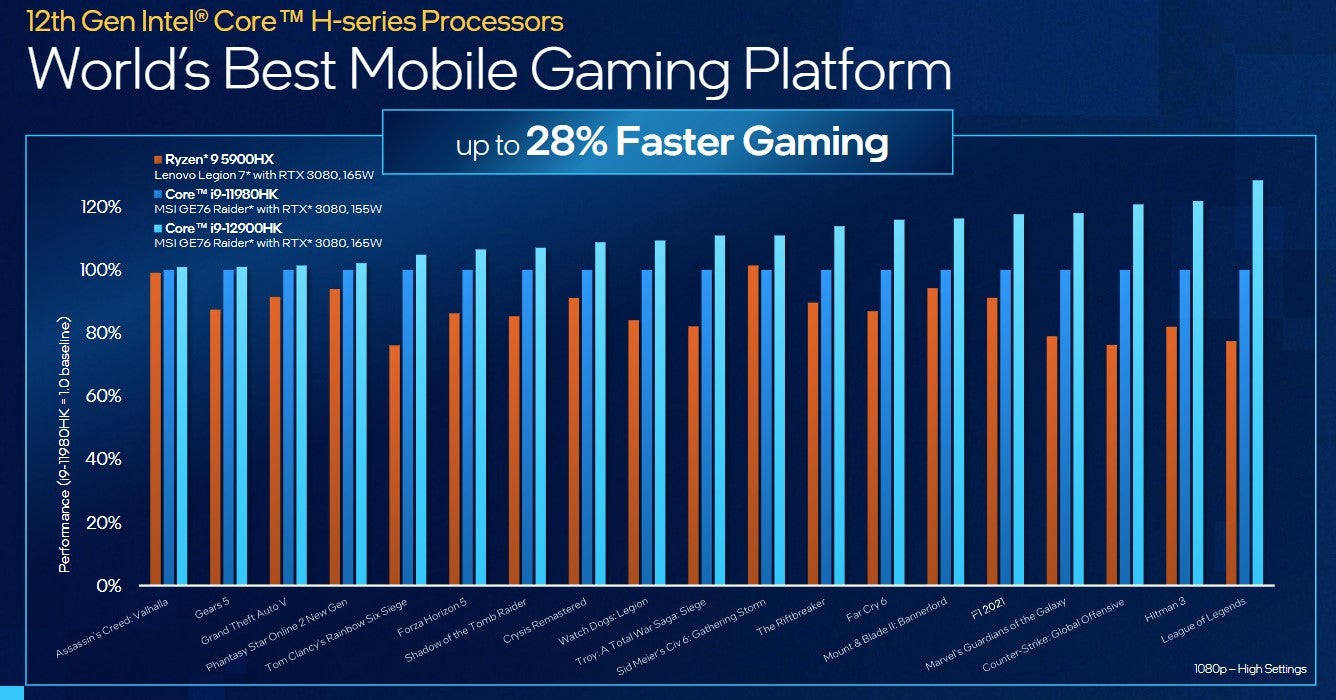
We tend to judge new chips by performance upgrades and power savings, but the raw numbers are a small piece of a much larger puzzle. What could have an even more significant impact on the next laptop you buy are the underlying technologies enabled by the new chips. With Intel’s 12th-gen chips, that means support for Wi-Fi 6E and DDR5 memory to go along with Thunderbolt 4.
Intel 12th-Gen Mobile: Wi-Fi 6E, DDR5 Memory, and More
Where Wi-Fi 6 boosted the capacity of the 2.4 GHz and 5 GHz bands, Wi-Fi 6E adds a third 6 GHz band. Maximum theoretical speeds remain 9.6 Gbps, but Wi-Fi 6E crucially adds more channels (up to 60) for wider bandwidth and capacity so dozens of connected devices can all maintain a fast, stable connection to your router. At least, in an ideal setup. You will need a Wi-Fi 6E router (sorry, your Wi-Fi 6 one won’t work) and they are nauseatingly expensive (think $US600 ($828)), and even then, the 6 GHz band has limited range.
What should have a more immediate effect out of the box is the DDR5 memory you’ll find on upcoming laptops — at least, the premium ones. We’ve been warned by MSI about supply shortages for DDR5 memory, but for now, most of the laptops announced at CES are equipped with it. DDR5 brings with it several performance enhancements, including higher bandwidth, starting at 4.8Gbps and reaching up to 6.4Gbps (up from a maximum of 3.2Gbps on DDR4), and the ability to run at a lower power state, which could potentially boost battery life.
A few things I haven’t touched on yet are battery life and graphics. When asked about what sort of endurance improvements to expect, Intel said any runtime gains would be system-based, not necessarily a direct product of the chips. As for graphics, most systems with H-series processors will rely on discrete graphics and potentially even use Intel’s Arc high-end graphics solution; when they aren’t playing games or running 3D simulations, these systems will fall back on integrated Iris Xe graphics.
While the 12th-gen desktop chips support PCIe 5, these mobile versions are limited to PCIe Gen 4, a decision Intel tells us is to keep costs down, and because no PCIe Gen 5 cards were available for validation.
New Intel Evo Program Pushes Remote Work Features
Previously restricted to ultra-mobile laptops powered by Intel U-series chips, Intel’s Evo program now extends to high-performance laptops.
You might have seen an “Evo” sticker on the palm rest of a Windows PC, which indicates the laptop has passed a specific gauntlet of standards set by Intel. These have to do with hitting certain performance and battery life benchmarks and containing modern features. With the debut of 12th-gen chips, Intel is moving the goalposts back.
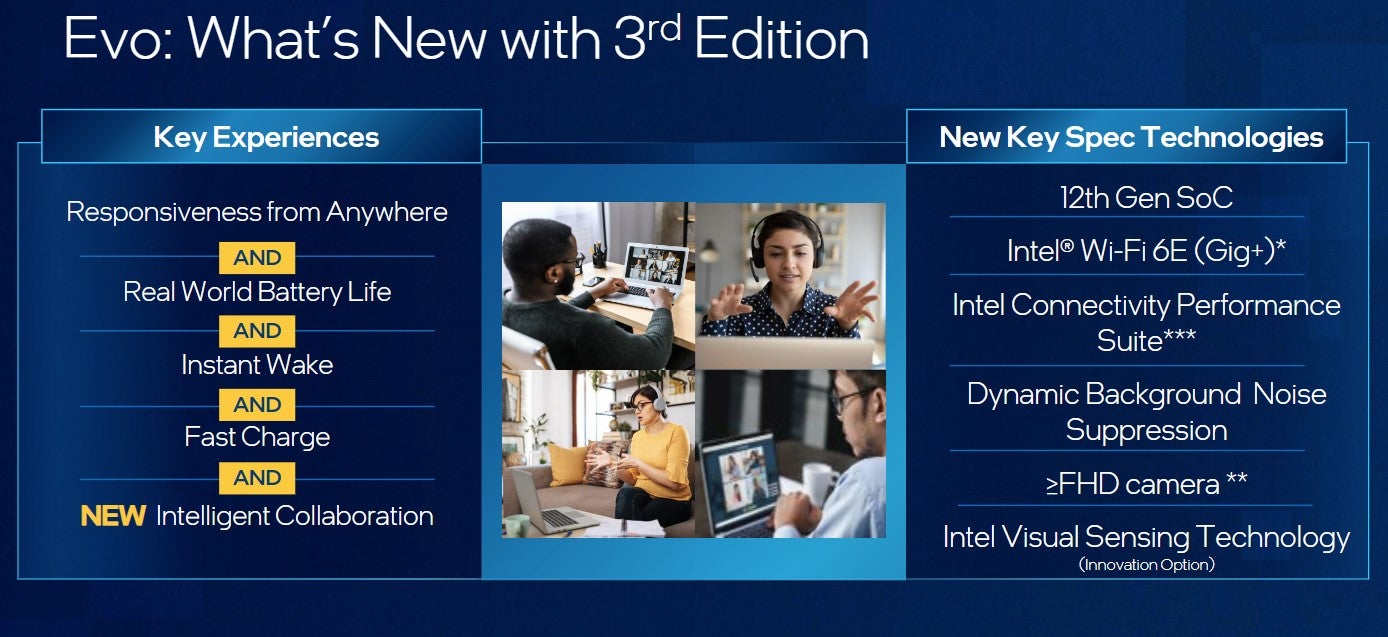
Where the second version of Evo focused on mobility, the third was designed to set minimum standards for collaboration. Some of the requirements are more about implementing technologies, like Wi-Fi 6E and Intel’s AI background noise suppression for video chats, while others are more concrete, like requiring high-quality mics or 1080p webcams. I say “concrete” but Intel concedes the full HD webcam requirement doesn’t apply to all systems because certain design elements, like ultra-thin bezels, won’t allow for a decent webcam. In that way, some of Evo’s requirements are rather fluid.
Also noteworthy is a new Evo program made specifically for devices with foldable displays. Lenovo’s ThinkPad X1 Fold is the only member of its kind on the market today, but Intel obviously thinks more are on their way.
What’s Next?
Dozens of Intel 12th-gen powered laptops are being announced at CES 2022 and are expected to arrive in the first few months of the year. We expect to receive review samples in the coming weeks, and will thoroughly test the performance of these H-series chips to see how they compare against Apple’s M-series and AMD’s Ryzen processors. Leaked benchmarks suggest these new hybrid chips could help Intel regain lost ground, but we’ll run our own to see not just how much raw speed they provide, but whether they have a marked impact on battery life.
What’s certain is the addition of Wi-Fi 6E and DDR5 memory will go a long way to ensuring your next laptop is future-proofed, and support for Thunderbolt 4 remains an advantage Intel enjoys over AMD.
This announcement is geared toward gamers and professionals who need to run demanding workloads, but it leaves out a large segment of PC users who need a portable laptop for work, school, or travel. Those, like Dell’s new XPS 13 Plus, will run on Intel’s P-series and U-series chips, which we should hear more about in the coming weeks.
